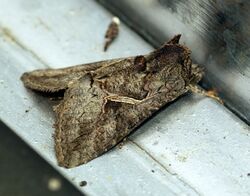Biology:Ctenoplusia albostriata
| Eastern streaked plusia | |
|---|---|

| |
| Scientific classification | |
| Domain: | Eukaryota |
| Kingdom: | Animalia |
| Phylum: | Arthropoda |
| Class: | Insecta |
| Order: | Lepidoptera |
| Superfamily: | Noctuoidea |
| Family: | Noctuidae |
| Genus: | Ctenoplusia |
| Species: | C. albostriata
|
| Binomial name | |
| Ctenoplusia albostriata (Bremer & Grey, 1853)
| |
| Synonyms | |
| |
Ctenoplusia albostriata, the eastern streaked plusia,[1] is a moth of the family Noctuidae. It is found in India , Sri Lanka, eastern Asia and the Pacific, including Borneo, Hong Kong, Vietnam, Japan , most of Australia and New Zealand.[2]
Description
The wingspan is about 30–42 mm. Palpi with short third joint. Hind femur of male not tufted with long hair. Head and thorax and forewings are full brown with a grey tinge. Sub-basal, antemedial and postmedial waved lines are brownish and indistinct. Orbicular narrow, elongate and brownish with white edges. There is a white streak found on median nervure conjoined to a brown streak with pale edges on vein 2, terminating at the postmedial line. A dark dentate submarginal line present. Hindwings fuscous with pale base.[3]
Its caterpillars are green pseudo-loopers. Body with sparse hairs and white tips. After last instar, it pupate in a loose cocoon in a curled up leaf.[4]
The larvae feed on various plants, including Conyza bonariensis and several other Asteraceae species, as well as Dichrostachys cinerea. Other recorded food plants include Erigeron, Symphytum, Calystegia, Elephantopus, Calendula, Callistephus, Dahlia, Solidago, Aster, Abelia, Dichrocephala and Polygonum.[5]
References
- ↑ "Eastern streaked plusia (Ctenoplusia albostriata)". https://www.inaturalist.org/taxa/eastern_streaked_plusia. Retrieved 19 August 2016.
- ↑ "エゾギクキンウワバ Ctenoplusia albostriata (Bremer & Grey, 1853)". http://www.jpmoth.org/Noctuidae/Plusiinae/Ctenoplusia_albostriata.html. Retrieved 19 August 2016.
- ↑ Hampson, G. F. (1894). The Fauna of British India, Including Ceylon and Burma: Moths Volume II. Taylor and Francis. https://www.biodiversitylibrary.org/item/180400#page/5/mode/1up.
- ↑ "Ctenoplusia albostriata (Bremer & Grey, 1853)". Butterfly House. http://lepidoptera.butterflyhouse.com.au/plus/albost.html. Retrieved 19 August 2016.
- ↑ "Ctenoplusia albostriata food plants". http://www.mothsofborneo.com/part-14/plusiinae/plusiinae_3_1.php. Retrieved 19 August 2016.
External links
| Wikimedia Commons has media related to Ctenoplusia albostriata. |
- Australian Faunal Directory
- Caterpillar Hostplants Database (as Agrapha albostriata)
- Pheromones and Semiochemicals of Ctenoplusia albostriata
Wikidata ☰ Q5191703 entry
 |

